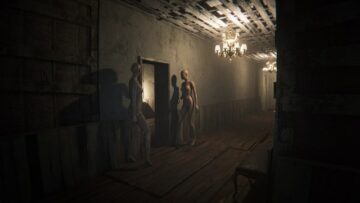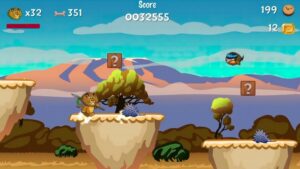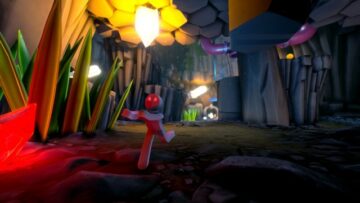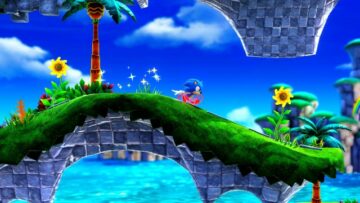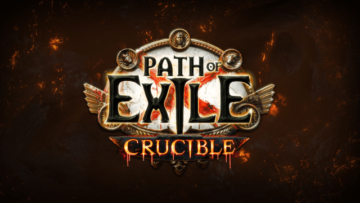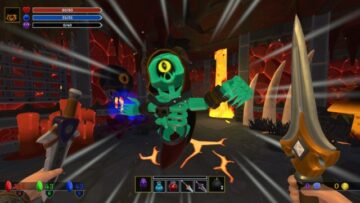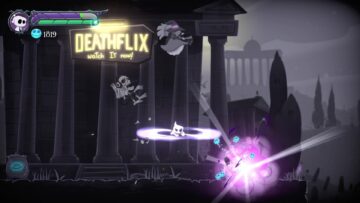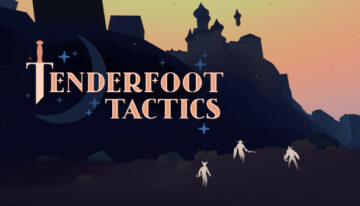Memories can snowball sometimes. One memory unlocks another one, and before long you’re wondering how you could have forgotten it all. It’s something we get when we meet up with old friends: we each remember different parts of the scene, filling in the gaps, until it feels as crisp and clear as watching on IMAX.
If this is a phenomenon, then Dordogne uses it as its foundation. It’s about a forty-something adult, Michelle, who has inherited her Grandma Nora’s house in rural France. But Nora and Michelle have been estranged for decades, as Michelle’s father and Nora had a raging argument and have not gone back to talking since. But with the keys to the cottage in Michelle’s hands, she returns to see what’s there, and that memory snowball starts rolling.


To be fair to Michelle, she does have some amnesia too. There’s hints of a trauma that triggered her loss of memory, including a summer holiday that she spent with her Grandmother. It’s this summer holiday that plays out in flashback, one week at a time, as you get to play as ‘Mimi’, the younger version of Michelle. The recollections bring you to the point where the trauma and estrangement coincided, bringing you full circle to the modern day.
Dordogne is painstakingly hand-painted in watercolours, which manages the dual feat of being unique, and applying a nostalgic wash on everything. The modern day sections in Dordogne are more glum, with a grey rinse to the events, while the moments in the past make glorious use of the full palette. The watercolour art style also helps with the gameplay. Stuff you don’t need to look at are pastel and undefined; while everything you should interact with has a thin outline and is more defined.
We stuck our hand up fast to review Dordogne, and it’s all down to that art style. Frankly, it’s gorgeous, and the Ghibli-esque characters toddling around the scenery are just as well realised and animated. So much care has gone into the visuals of Dordogne, and they make it feel like an artefact that you’ve found in the back of the closet, rather than a modern game. It’s lovely.
As is the case with a lot of narrative adventures, Dordogne wrestles with how much gameplay to give the player. It veers from talky, explorative sections to more minigamey sequences, using the controller to emulate the actions of making lunch, turning locks in doors, and fixing kayaks. These sections never found a sweet spot: we never felt like we were free to tinker with items fully, as giant-sized prompts appeared on the screen telling us exactly what we were meant to do. We were never stuck, sure, but we felt like someone was behind us, manipulating our hands and pushing our head to look where it wanted us to look.
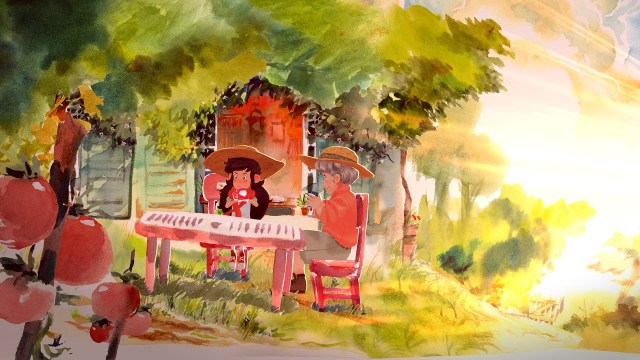

Movement around the environments of Dordogne feels a bit like those early Resident Evil games, which is a comparison we didn’t expect to make. Two different mansions, two very different moods. It’s not quite as frustrating as those games, but it’s the same fixed, elevated scenes with laboured movement around them. We got stuck behind tables and fumbled our way slowly through environments that wanted to hem us in to particular spots. Dordogne can never make navigation as comfortable and blissful as the watercolours themselves, which is a real shame. We wanted to explore – the paintings positively demanded it – but it occasionally felt like we were bumping around from blockage to blockage.
Dordogne has a taste for collectibles. Early in the game, Mimi gains a scrapbook, and it acts as many things: a reminder of what you should be doing; a place for all the things you find in the world; and an opportunity for free-form expression, as you can use all the stickers, photos and sounds you collect to create pages with poems on them, recalling your holiday. The free-expression stuff in particular is brilliant. We’d have liked slightly bigger pages than were on offer, so that we could actually fit stuff on it, but there’s something very sweet and endearing about being able to construct your own collages.
The downside is that collecting the stickers and photos is more laborious than it really should have been. Dordogne plays out in a series of weeks in largely the same place: Grandma Nora’s cottage. If you want to collect everything the game has to offer, you will need to visit all ten rooms of the house, the grounds of the house, and perhaps the odd satellite location – you get to visit caves and marketplaces – each and every week of the game, both in the past and the future. That means visiting the same bedrooms and living rooms dozens of times, treading old ground on the off-chance that a paper, word, cassette tape or other goodie is waiting for you. It’s a completionist’s nightmare: if you don’t do this sweep every, single time, then there’s a frustrating gap in the scrapbook.
You don’t get to revisit these areas. Completing the game doesn’t open up chapters that you can return to. This is one canonical, linear experience, which makes sense from a believability perspective, but also means that the vast majority of achievements – and a fair amount of narrative – can be bypassed, which never quite feels right.
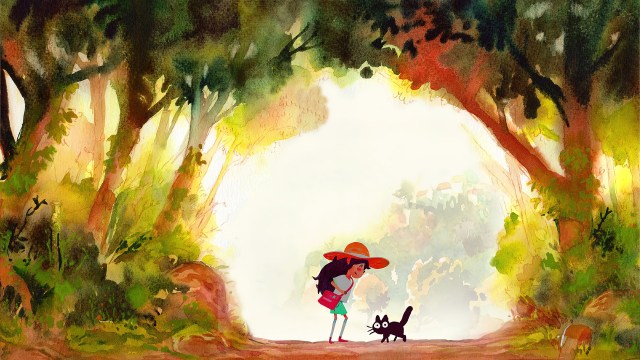

We’re narked because that story is well worth experiencing. The grumbly Mimi and the stern Nora soon grow to appreciate each other, and there is a believable – if slightly short – arc to their characters. It does what it sets out to do, which is make you feel a deep sense of loss, not for Nora necessarily, but for the time that Mimi and Nora could have spent together, lost to a petty familial dispute. It’s that loss that chimed with us most, bringing on the tears.
The dialogue is extremely strong, even when translated from its native French. Characters and exchanges are believable. A late-game magic-realist moment even lands well when it could have been mawkish and inauthentic. It’s all handled so well.
Dordogne is an imperfect package, then: a beautiful porcelain plate of a game that has cracks in it. The plate is unique enough to warrant purchase (or a free spin on Game Pass), but we wonder what it would have been like with more gameplay care. A pass on the controls, a sandpapering of the many obstacles to exploration, and a better approach to its collectibles would have done wonders.
But time and time again, Dordogne would whisk us away somewhere beautiful, and all would be forgiven. Sometimes you can live with cracks in the plate.
- SEO Powered Content & PR Distribution. Get Amplified Today.
- EVM Finance. Unified Interface for Decentralized Finance. Access Here.
- Quantum Media Group. IR/PR Amplified. Access Here.
- PlatoAiStream. Web3 Data Intelligence. Knowledge Amplified. Access Here.
- Source: https://www.thexboxhub.com/dordogne-review/
- 1
- a
- able
- About
- achievements
- acts
- actually
- again
- AI
- All
- also
- Amnesia
- amount
- an
- and
- animated
- Another
- applying
- appreciate
- approach
- ARE
- areas
- around
- Art
- as
- At
- away
- back
- BE
- beautiful
- because
- been
- before
- behind
- being
- Better
- bigger
- Bit
- both
- bring
- bringing
- but
- CAN
- care
- case
- characters
- Circle
- clear
- coincided
- collect
- collectibles
- Collecting
- comparison
- completing
- Construct
- content
- controller
- controls
- could
- create
- CRISP
- day
- decades
- deep
- defined
- demanded
- dialogue
- different
- Dispute
- do
- does
- doing
- done
- doors
- down
- downside
- dozens
- each
- Early
- end
- enough
- environments
- even
- events
- Every
- everything
- exactly
- Exchanges
- expect
- experience
- experiencing
- exploration
- explore
- expression
- extremely
- fair
- FAST
- feat
- feel
- filling
- find
- fit
- fixed
- For
- forgotten
- Foundation
- France
- Free
- French
- Friends
- from
- frustrating
- full
- Full Circle
- fully
- future
- gains
- game
- Game Pass
- gameplay
- Games
- gap
- gaps
- Get
- give
- gone
- Ground
- Grow
- had
- hand
- hand-painted
- hands
- has
- Have
- head
- helps
- her
- holiday
- House
- How
- HTTPS
- if
- in
- Including
- interact
- into
- Is
- IT
- ITS
- jpg
- just
- keys
- lands
- largely
- like
- Live
- living
- location
- Locks
- Long
- Look
- loss
- lost
- lot
- Majority
- make
- MAKES
- Making
- many
- marketplaces
- means
- meant
- meet
- memory
- Modern
- moment
- moments
- more
- most
- movement
- much
- narrative
- native
- Navigation
- need
- never
- not
- obstacles
- Odd
- of
- offer
- Old
- on
- One
- open
- Opportunity
- or
- Other
- our
- out
- own
- package
- paintings
- palette
- Paper
- particular
- parts
- pass
- Past
- perhaps
- perspective
- phenomenon
- photos
- place
- plato
- plato data intelligence
- platodata
- platogaming
- play
- player
- plays
- Point
- purchase
- pushing
- quite
- raging
- rather
- Real
- really
- Remember
- Resident Evil
- return
- returns
- review
- right
- Rolling
- Rooms
- Rural
- same
- satellite
- scene
- scenes
- Screen
- see
- sense
- Series
- sets
- she
- Short
- should
- since
- single
- So
- some
- someone
- something
- Sometimes You
- Soon
- Spin
- Spot
- Stickers
- Story
- strong
- style
- summer
- Sweep
- sweet
- talking
- taste
- ten
- than
- that
- The
- The Future
- The Game
- the world
- their
- Them
- themselves
- then
- there
- These
- they
- things
- this
- those
- Through
- time
- times
- to
- together
- too
- turning
- two
- unique
- unlocks
- until
- up
- us
- use
- uses
- using
- vast
- version
- very
- Visit
- visuals
- waiting
- want
- was
- watching
- way
- we
- week
- weeks
- well
- were
- What
- when
- where
- while
- WHO
- will
- with
- wondering
- world
- worth
- would
- you
- your
- zephyrnet
